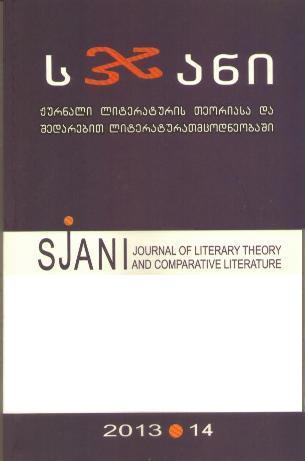შუასაუკუნეებისა და რენესანსის ესთეტიკურ კატეგორიათა ურთიერთმიმართებისათვის (სილამაზე/მშვენიერება)
On the Relationship of
Medieval and Renaissance
Aesthetic Categories
(Beauty)
Author(s): Maka ElbakidzeSubject(s): Literary Texts
Published by: ლიტერატურის ინსტიტუტის გამომცემლობა
Keywords: concept of beauty; Medieval aesthetics; Renaissance aesthetics; Dante; Rustaveli.
Summary/Abstract: On the Relationship of Medieval and Renaissance Aesthetic Categories (Beauty) Summary Key words: concept of beauty; Medieval aesthetics; Renaissance aesthetics; Dante; Rustaveli. Since the period of Antiquity the concept of beauty has been considered one of the main factors of aesthetic perception of objective reality. The idea of beauty depends on man’s social position, his way of life and style, peculiarities of the national culture; it is also determined by the level of individual culture and peculiarities of a person’s aesthetic taste. Accordingly, each epoch elaborates aesthetic paradigms unique only to it, which along with political, socio-economical and moral and ethical factors, is undoubtedly a determinant of specific character of historical epochs and cultures. The purpose of this paper is to show how the concept of beauty was understood in the Medieval and Renaissance epochs, what relationship existed between these two cultural paradigms in relation to the aesthetic categories under study from the viewpoint of dependence. In the early Medieval art and literature the outer beauty was perceived not with its unique meaning but as a radiance of spiritual perfection. This principle is changed in the late medieval period, particularly, in secular literature where along with the personality traits of a protagonist, his portrait strokes come into the fore. This means that artistic image of a personage is created not according to the general model (saint/sinner; positive personage/negative personage) established in hagiography but by maximal shaping of individual traits of a personage and in such way that the appearance of the person would mirror his inner (spiritual) image. Hence, an extraordinary beauty of these personages, which in the majority of cases is rendered by a metaphor for the sun, signifies their distinctness, dignity, high moral. The paper underlines that it is this tendency that can be considered as the basis of anthropocentricity which is one of the main characteristics of the Renaissance - the epoch that followed on the Middle Ages. It is anthropocentricity that the cult of beauty characteristic to the Renaissance epoch is associated with, moreover that not only special attitude towards beauty characterizes the Renaissance aesthetics but also longing for a beautiful life. A kind of harmony is being created – man satisfies a thirst for beauty in the works of art, hence, it can be said that art is in the service of life, and life is in the service of art. However, in specialist literature it is emphasized that the desire to present life in this world as beautiful and perfect, the elaboration of a totally new, attractive worldly ideal started much earlier than the Italian quattrocento. In this case it concerns the late Middle Ages which left an immense heritage to the subsequent epoch.
Journal: სჯანი
- Issue Year: 2013
- Issue No: 14
- Page Range: 77-90
- Page Count: 13
- Language: Georgian

